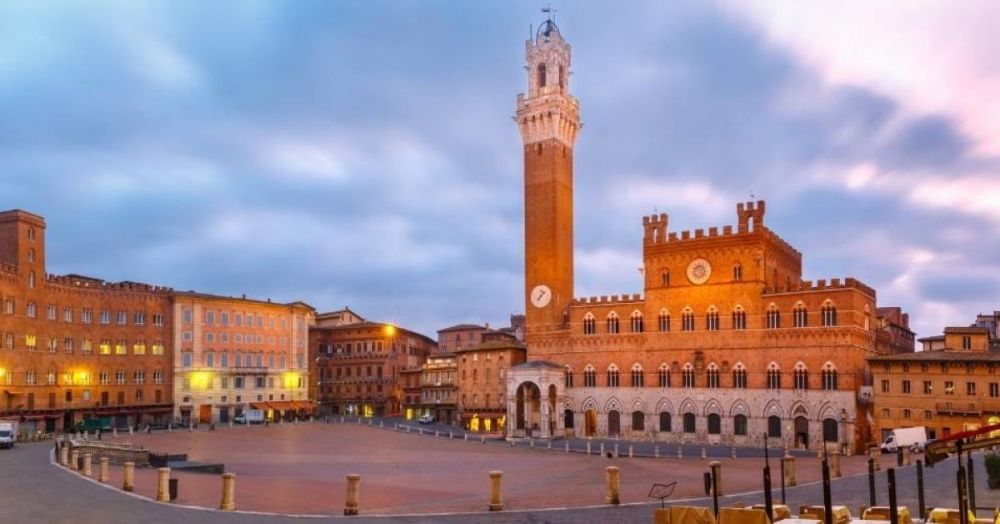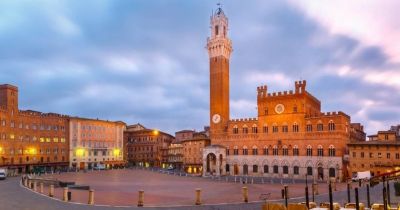

Situated in the Piazza del Campo, the Torre del Mangia is one of Siena's most iconic landmarks. Built in the 14th century, this historic bell tower offers a unique opportunity to view the city from above. Climbing the 400 steps to the top can be a challenge, but the breathtaking panoramic vistas of Siena and the surrounding Tuscan countryside are absolutely worth the effort. The tower stands at over 88 meters tall and is named after its first bell-ringer, Mangiaguadagni, which translates to 'eat the profits', pertaining to his well-known gluttony. As visitors ascend the narrow staircase, they should take note of the magnificent craftsmanship of the tower, and upon reaching the summit, they can enjoy an unobstructed view that stretches for miles. Exploring Torre del Mangia gives travelers a glimpse into the architectural and cultural history of Siena, making it an unforgettable experience.
Palazzo Pubblico, the historic town hall, is another must-see attraction in Piazza del Campo. This Gothic-style building dates back to the 13th century and serves as the heart of civic life in the city. Its impressive architecture and intricate frescoes offer a captivating look at Siena's rich heritage. Inside, visitors can explore several museum rooms, including the Sala del Mappamondo and the stunning Sala dei Nove, adorned with frescoes by Ambrogio Lorenzetti. These rooms display scenes of everyday life and allegorical representations of good and bad government, giving an insight into the political and social mindset of medieval Siena. The Palazzo Pubblico is a testament to the city's historical wealth and power, and it continues to be an inspiring venue for studying medieval art and architecture. A tour of the Palazzo is often combined with a visit to the adjacent Torre del Mangia for a full experience of Sienese history.
A walking tour of Piazza del Campo is the perfect way to immerse oneself in the historical and architectural splendor of Siena. Recognized as one of Europe's greatest medieval squares, it offers a glimpse into the city's past, showcasing a remarkable fan-shaped design. The tour encompasses various significant sites, such as the Fonte Gaia fountain and the numerous palazzos that line the piazza. A knowledgeable guide explains the history of the Il Palio, the famous horse race held twice a year in the piazza, and shares stories of Siena's intriguing past. Visitors will learn about the city's rivalries with Florence, its traditional contrade (neighborhoods), and the rich traditions that have been preserved over the centuries. The walking tour is both educational and entertaining, providing an excellent introduction to Sienese culture and the architectural beauty that the city has to offer.
Sampling Siena's traditional sweets is a delectable activity for those with a sweet tooth exploring Piazza del Campo. The shared romance of Tuscan confectionery is best experienced through its local delicacies, such as Panforte, a dense and chewy cake-like confectionery peppered with nuts, fruits, and spices, or Ricciarelli, soft almond-based biscuits with a touch of orange zest. Visitors can stop by one of the many pasticcerias around the square, where these sweet treats and other local desserts like Cantucci and Cavallucci are freshly made. As travelers delight their palates, they'll find themselves transported to ancient Siena through the flavors and stories behind these treats. Food tours may incorporate tastings of these sweets, or alternatively, visitors can opt to leisurely enjoy them at a local café with a cup of Italian espresso or Vin Santo, a traditional Tuscan dessert wine. This activity offers not only a taste of Sienese culture but also an opportunity to bring back these treats as delicious souvenirs.
Visitors to Piazza del Campo can enjoy a tranquil moment by the Fonte Gaia, one of the most significant monuments in Siena. This stunning fountain was completed in the 15th century and is enriched with elaborate marble sculptural work attributed to the celebrated artist Jacopo della Quercia. The fountain represents joy and was so named because of the jubilation felt by the citizens of Siena when water was first brought to the center of the city. The Fonte Gaia is not only a masterpiece of Renaissance sculpture but also a popular gathering place for both locals and tourists, offering a chance to rest and admire the charming setting of the square. Although the original sculptures by Jacopo della Quercia have been replaced by copies to preserve them, the history and symbolism of the fountain remain vibrant. Visitors are often found sitting by the water, enjoying gelato, or capturing the fountain's beauty through photography, a serene contrast to the bustling city life around it.
Attending the Palio di Siena, a historic horse race that dates back to the 16th century, is a once-in-a-lifetime event for those visiting during the race dates (July 2 and August 16). This fiercely competitive race involves horses representing 10 of the city's 17 contrade racing around Piazza del Campo's shell-shaped track. The event starts with a spectacular pageant, the Corteo Storico, which features participants in medieval costumes, flag-throwers, and drummers moving through the city to the piazza. The atmosphere in Siena during the Palio is electric, with enthusiastic crowds and local residents passionately supporting their contrada. The actual race is quick and intense, lasting just 90 seconds, but the buildup and celebrations make it an all-day affair. The Palio di Siena isn't just a race; it's a deep-rooted cultural tradition that encapsulates the spirit, rivalry, and pride of the Sienese people.
Strolling around Piazza del Campo, visitors have the opportunity to engage in artisanal shopping at local boutiques and craft shops. The square is surrounded by numerous establishments offering a variety of locally crafted goods, perfect for those seeking unique souvenirs or handcrafted art. Shoppers can find everything from fine ceramics and intricate ironwork to leather-bound journals and hand-woven textiles. Each piece tells a story of Sienese craftsmanship and tradition. While exploring these artisanal products, visitors are also directly supporting the local economy and preserving the traditional skills that have been passed down through generations. The shopping experience in Piazza del Campo is enhanced by the charm and history that the square itself exudes, making it an inviting place to browse and discover the artistic talents of Siena.
One of the most relaxing and pleasurable activities to partake in at Piazza del Campo is enjoying an aperitivo with a view. As evening approaches, the historic square bustles with locals and tourists alike, settling into the cozy outdoor seating of the numerous cafés and bars lining the perimeter. An aperitivo typically consists of a glass of Tuscan wine, such as a refreshing Vernaccia or a bold Chianti, accompanied by a selection of light appetizers like bruschetta, olives, cheeses, and cured meats. It's a time-honored tradition intended to whet the appetite before dinner while savoring the captivating atmosphere of the piazza. The warm golden hues of the fading sunlight cast against the beautiful facades of the surrounding medieval buildings create an unforgettable backdrop. An aperitivo here is not just about the food and drink; it's about embracing the quintessential Italian lifestyle and enjoying the moment.
Photography enthusiasts will find Piazza del Campo to be a treasure trove of picturesque sights, making a photography tour a must-do activity. The square's unique fan shape, combined with the striking contrast of Gothic architecture against the open skyline, presents endless opportunities to capture stunning images. Whether you're an amateur with a smartphone or a professional with high-end gear, the varied elements of light, shadow, and texture offer a canvas to practice your skills. Participants can learn about composition, exposure, and other photographic techniques from an expert guide. Early morning or late afternoon tours are particularly sought after for the soft, diffused light that gives the historic buildings a magical glow. As you maneuver through the square and its adjacent streets, you'll not only create beautiful mementos of your visit but also develop a deeper understanding and appreciation of Siena through your lens.
For those intrigued by the mysterious and supernatural, a historical evening ghost tour of Piazza del Campo and the surrounding labyrinth of medieval streets offers a chilling yet fascinating experience. Guides dressed in period costumes lead the way, narrating tales of the unexplained phenomena and eerie legends that are part of Siena's past. Visitors will learn about ancient myths, curses hiding behind the city's rich history, and ghostly apparitions reported through the ages. The tour often includes lesser-known spots that locals believe to be haunted and stories that have been passed down from generation to generation. An evening ghost tour is an alternative way to explore Siena's heritage, adding an element of excitement and suspense to the journey through the city's dark corners and dimly lit alleys.
